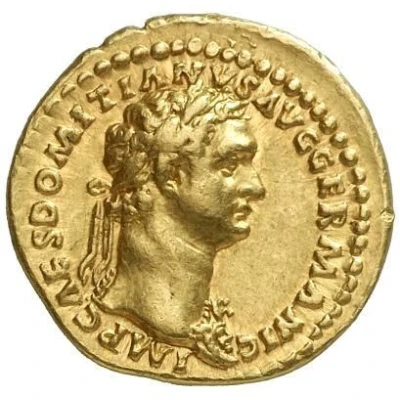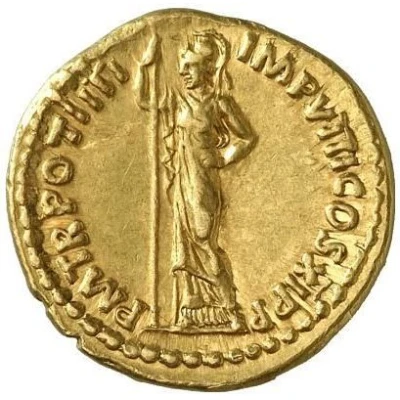Aureus - Domitian P M TR POT IIII IMP VIII COS XI P P
85 year| Gold | - | - |
| Issuer | Rome › Roman Empire (27 BC - 395 AD) |
|---|---|
| Emperor | Domitian (Titus Flavius Domitianus) (81-96) |
| Type | Standard circulation coin |
| Year | 85 |
| Value | 1 Aureus = 25 Denarii |
| Currency | Denarius, Reform of Augustus (27 BC – AD 215) |
| Composition | Gold |
| Shape | Round (irregular) |
| Technique | Hammered |
| Demonetized | Yes |
| Updated | 2024-10-05 |
| Numista | N#251699 |
|---|---|
| Rarity index | 100% |
Reverse
Eagle standing front on thunderbolt, head left, wings spread.
Script: Latin
Lettering: P M TR POT IIII IMP VIII COS XI P P
Translation:
Pontifex Maximus, Tribunicia Potestate Quarta, Imperator Octavum, Consul Undecimum, Pater Patriae.
High priest, holder of tribunician power for the fourth time, supreme commander (Imperator) for the eighth time, consul for the eleventh time, father of the nation.
Comment
Source: Online Coins of the Roman Empire (OCRE)Interesting fact
The Aureus - Domitian (P M TR POT IIII IMP VIII COS XI P P) (85) coin was minted during the reign of Emperor Domitian, who ruled the Roman Empire from 81 to 96 AD. It's made of gold and features an image of the emperor on one side and a depiction of the goddess Victory on the other. The coin was used as a means of payment and was considered a high-value denomination during its time. It's interesting to note that the coin's design and inscriptions reflect the political and religious beliefs of the Roman Empire during Domitian's reign. The image of Victory on the coin, for example, symbolizes the empire's military power and dominance. Additionally, the inscription "P M TR POT IIII IMP VIII COS XI P P" indicates that Domitian was the fourth emperor of the Flavian dynasty and that he held various titles and powers, including that of Pontifex Maximus, Tribune, and Consul. Overall, the Aureus - Domitian (P M TR POT IIII IMP VIII COS XI P P) (85) coin is a valuable piece of history that provides insight into the Roman Empire's economy, politics, and culture during the late 1st century AD.



